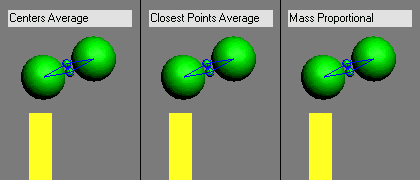|
|
 |
PhysX Glue Test: Rigid/Simplified Binding Rollouts
Binding Anchor Placement - Choose how the software determines placement of the binding anchors:
-
Centers Average - Places the main anchor of a binding at the center point of particles' pivots, and orients the main anchor axis along the vector between particles.
-
Closest Points Average - Determines the closest points of each pair of particles' collision shapes, and then places the main anchor halfway between these.
The main anchor axis is perpendicular to the shape surfaces at the closest points.
In this case, when the main anchor axis is not oriented along the vector between particles, the binding becomes more brittle along the contact surfaces and less gluey. So if you have a brick wall to destroy, for example, use this setting.
-
Mass Proportional - Places the main anchor point of a binding in reverse cubic ratio to the particle masses. This is done to approximate the following situation:
Imagine spherical particles with different sizes and the same density. Suppose you create bindings for particles that touch each other.
In such a situation, it's better to create the main anchor point (as a possible breaking point) at the point of the contact.
The contact point in this case can be calculated as a weighted average of particle positions, where the weight coefficients are cubic root of particle masses. Use the Mass Proportional option when you have different-sized, somewhat spherical particles to bind.
Example 1:
PhysXGlueRigid_BindingAnchorPlacement_01.zip

Example 2:
PhysXGlueRigid_BindingAnchorPlacement_02.zip

|